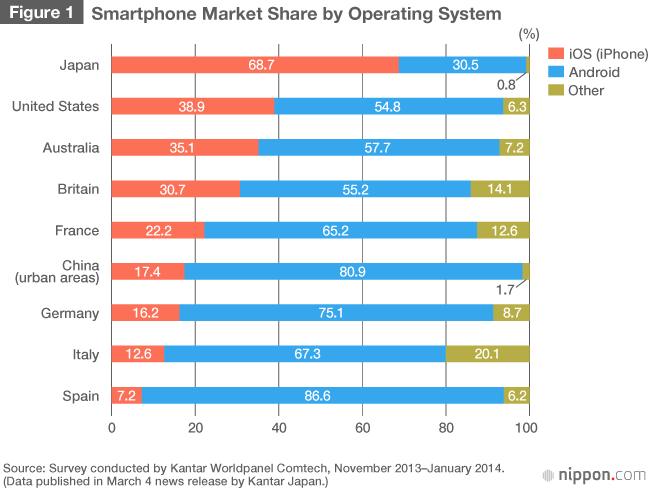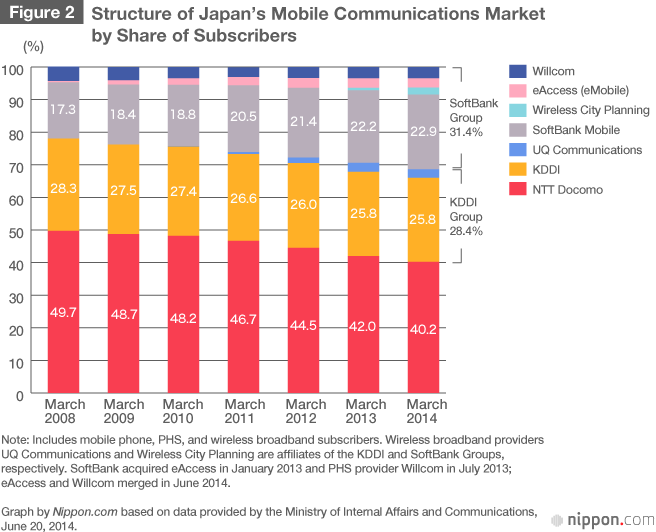
Shaking Up Japan’s Mobile Phone Market
Economy- English
- 日本語
- 简体字
- 繁體字
- Français
- Español
- العربية
- Русский
Since Japan’s leading mobile operator NTT Docomo joined its two major competitors in offering the iPhone last September, the nation’s mobile phone market has fallen into a state of virtual homogeneity, with little to distinguish the three main carriers in terms of handsets or services. This has set the stage for the kind of price war that all the providers are anxious to avoid.
Playing “Chicken” with Cash-Back Offers
According to data compiled by market research company Kantar Japan, iPhones accounted for 68.7% of smartphones sold between November 2013 and January 2014. With Docomo, KDDI (which offers mobile service under the Au brand), and SoftBank all offering the dominant iPhone along with Android handsets, customers were no longer choosing a mobile carrier on the basis of its lineup of devices.
That said, there was little to distinguish the Big Three in terms of rate plans or service quality, either. This situation set the stage for a “cash-back war,” as carriers sought to lure customers from each other with increasingly generous money-back offers. Some of these rebates amounted to tens of thousands of yen; an early campaign offered an unbelievable ¥70,000 back on each device. People were boasting of going on family vacations using the money they had earned by buying smartphones for the whole household.
The truth is that all the carriers would have liked to scale back these profit-eating giveaways, but none of them dared to as long as their competitors were providing generous incentives. What started as a short-term stimulus designed to boost new contracts had become a means of survival.
From the customers’ viewpoint, cash-back campaigns are great incentives for signing up with a carrier, but they offer no reward for staying with the same company over the long haul. In fact, as these offers escalated, longtime customers voiced growing resentment at being cut out of the action.
In March 2014, at the height of the cash-back battle, word spread over the Internet that the Ministry of Internal Affairs and Communications (MIC) had “instructed” mobile phone carriers to suspend their rebate campaigns. These rumors of government intervention threw cold water on the cash-back frenzy and gave the Big Three the opportunity for a simultaneous withdrawal. The cash-back war was at an end.

NTT Docomo Leads the Pack with Unlimited Talk
In mid-April this year, during the calm following the cash-back battle, NTT Docomo took the opportunity to announce the June rollout of two discount service plans, Kake-hōdai and Pake-aeru. Under the first plan, subscribers can make unlimited calls to any phone in the country for a flat rate of ¥2,700 per month. The second plan allows for family sharing of monthly data quotas. Meanwhile, the company moved to give loyal users service discounts based on the length of time they have held contracts with NTT Docomo; the company boasts a large number of longtime individual and household subscribers who have never used another carrier.
The inauguration of Japan’s first flat-rate unlimited calling plan was a bold move by NTT Docomo to reverse the flow of subscribers toward its competitors, a trend that had continued even after its launch of iPhone sales last September. The announcement sent ripples through the industry, and the new pricing system proved a huge hit with customers. In mid-May, when the new plans became available, customers rushed to shops to sign up in advance, producing three-hour waits at some outlets. The largest response came from frequent callers, such as younger users and businesses, with a fair number of new customers jumping ship from rival carriers.
The new flat-rate plan allows frequent callers to save big on mobile charges, but it deprives the company of a major source of revenue in the process. To break even, NTT Docomo also needs to sign up light to moderate telephone users, who will end up paying more than under the ¥743 basic plan. It is still unclear how many will make the switch, but with over 5 million new contracts signed in the first 50 days, NTT Docomo’s gamble appears to be paying off.
SoftBank and KDDI Struggle to Keep Pace
Of course, KDDI and SoftBank have not sat idly by. The nation’s second- and third-ranking carriers have rolled out their own plans in a desperate bid to prevent further defections to their rival.
Speaking at a press conference, KDDI president Tanaka Takashi said that his sales department begged him to take action to respond to NTT Docomo’s new rate plan, which was having a huge impact on sales. Under pressure, KDDI hastily bumped up the kickoff of its new low-cost calling plan from December to August 2014. The plan was originally scheduled for launch in tandem with KDDI’s new VoLTE (voice over LTE) service, which allows the company’s high-speed Long-Term Evolution network to carry high-definition voice calls as well as large amounts of data.
SoftBank also struggled to regain its footing. Back in January 2014 it had announced its own new rate plan, billing it as “a plan for the coming VoLTE era.” Scheduled for rollout in mid-April, the plan would have allowed 1,000 calls of up to five minutes each and seven gigabytes of data for ¥6,980 a month. The plan’s cost immediately came under fire from customers and Internet commentators, and SoftBank scrapped it in April 2014 prior to implementation in response to NTT Docomo’s flat-rate announcement. In June, SoftBank announced a plan similar to NTT Docomo’s. (SoftBank’s flat-rate plan was launched in July.)
New Smartphone Rate Plans
| NTT Docomo | KDDI | SoftBank | |
|---|---|---|---|
| Launch date | June 1, 2014 | August 13, 2014 | July 1, 2014 |
| Unlimited calling (domestic) | ¥2,700 | ¥2,700 | ¥2,700 |
| Network access fee | ¥300 | ¥300 | ¥300 |
| Mobile data (2GB) | ¥3,500 | ¥3,500 | ¥3,500 |
| (3GB) | ¥4,200 | ||
| (5GB) | ¥5,000 | ¥5,000 | ¥5,000 |
| (8GB) | ¥6,800 | ||
| (10GB) | ¥9,500 | ¥8,000 | ¥9,500 |
| (13GB) | ¥9,800 | ||
| (15GB) | ¥12,500 | ¥12,500 | |
| (20GB) | ¥16,000 | ¥16,000 | |
| (30GB) | ¥22,500 | ¥22,500 |
(Prices do not include consumption tax.)
SoftBank Cedes Rate Initiative to NTT Docomo
SoftBank had hoped to lead the pack with its new rate plan and force the other major carriers to play catch-up with similar contracts. The aim was to set the trend with a rate structure that ensured steady profits, avoiding a damaging price war. SoftBank is depending on the profits it earns in Japan to finance its plans for expansion into the US telecommunications market.
SoftBank has already used its Japanese revenues to acquire Sprint Nextel. But President Son Masayoshi has said he will need to purchase the number four carrier T-Mobile US as well to break AT&T and Verizon’s dominance of the US mobile market. Even assuming he can pull off such a merger, his company faces tough financial challenges going forward. SoftBank outpaced NTT Docomo in fiscal 2013 with ¥1 trillion in operating income, but the carrier is sitting on over ¥9 trillion in interest-bearing debt. SoftBank’s preemptive announcement of a new rate plan was motivated by the need to establish a profit-maximizing structure in order to rebuild Sprint and acquire T-Mobile US.
Clearly, things did not unfold according to SoftBank’s plan. Ultimately it was NTT Docomo that set the pace with its unlimited-talk plan, with SoftBank and KDDI hustling to keep pace.
After buying out Vodafone Japan in 2006, SoftBank emerged as the market’s trendsetter, introducing a low-cost basic-service plan at a monthly rate of ¥980 and becoming the first domestic carrier to offer the iPhone. But in 2011, KDDI began handling the iPhone as well, and in 2012 it challenged SoftBank’s leadership in rate setting by offering discount bundles combining mobile smartphone plans with fixed-line voice and internet services using its fiber-optic and cable broadband networks. (SoftBank does not have its own broadband network for home use.) More recently, NTT Docomo seized the pricing initiative with its unlimited-talk plan.
Meanwhile, impending moves to loosen regulation of the telecommunications market could seal the dominance of the NTT Group, Japan’s former telecommunications monopoly. Antimonopoly rules have previously prevented NTT Docomo from making use of the fiber-optic cable networks of NTT East and NTT West, which control most optical communications in Japan, but those rules are set to be lifted. At a shareholder meeting on June 19, NTT Docomo president Katō Kaoru announced plans to roll out a discount bundle combining its own wireless service with NTT fiber-optic connectivity.
Breaking the Market Wide Open
At the same time, competition is heating up from Japan’s emerging mobile virtual network operators (MVNOs), which provide budget mobile communications service using the major carriers’ infrastructure. MVNOs have been attracting attention with plans as low as ¥2,000–¥3,000 per month, including a device.
The trend was sparked in April of this year, when retailing giant Aeon launched a sales campaign targeting older customers who were interested in smartphones but deterred by the high cost of typical data packages. Aeon initially offered just 8,000 low-cost smartphones, which sold out almost immediately. Its success has encouraged other enterprises, including an Internet service provider and an optical cable company, to enter the fray with their own budget smartphones and mobile services.
In a move expected to benefit the MVNOs, an MIC panel called for new rules requiring mobile phone carriers to remove the SIM locks on their phones beginning in 2015, thus allowing handset owners to switch carriers without purchasing new devices. At present, the Big Three control some 90% of the mobile market, discouraging competition from innovative newcomers. ADSL provider eAccess tried to penetrate the market, only to be bought out by SoftBank in 2013. The government seems determined to open the field to other players and stimulate competition by helping to do away with SIM locks and giving a leg up to MVNOs.
In the United States, the rapid growth of MVNOs has given consumers a range of choices beyond that offered by the country’s four main carriers. It will remain to be seen whether Japanese consumers take to MVNOs in the same way.

(Originally published in Japanese on July 15, 2014.)
▼Further reading
 The Future of the Japanese Smartphone Market Following the Docomo iPhone The Future of the Japanese Smartphone Market Following the Docomo iPhone |  SoftBank’s Son Masayoshi Aims to be Number One SoftBank’s Son Masayoshi Aims to be Number One |  Steve Jobs and Japan Steve Jobs and Japan |
smartphone Apple iPhone Son Masayoshi Softbank NTT Docomo KDDI The Ministry of Internal Affairs and Communications MVNO